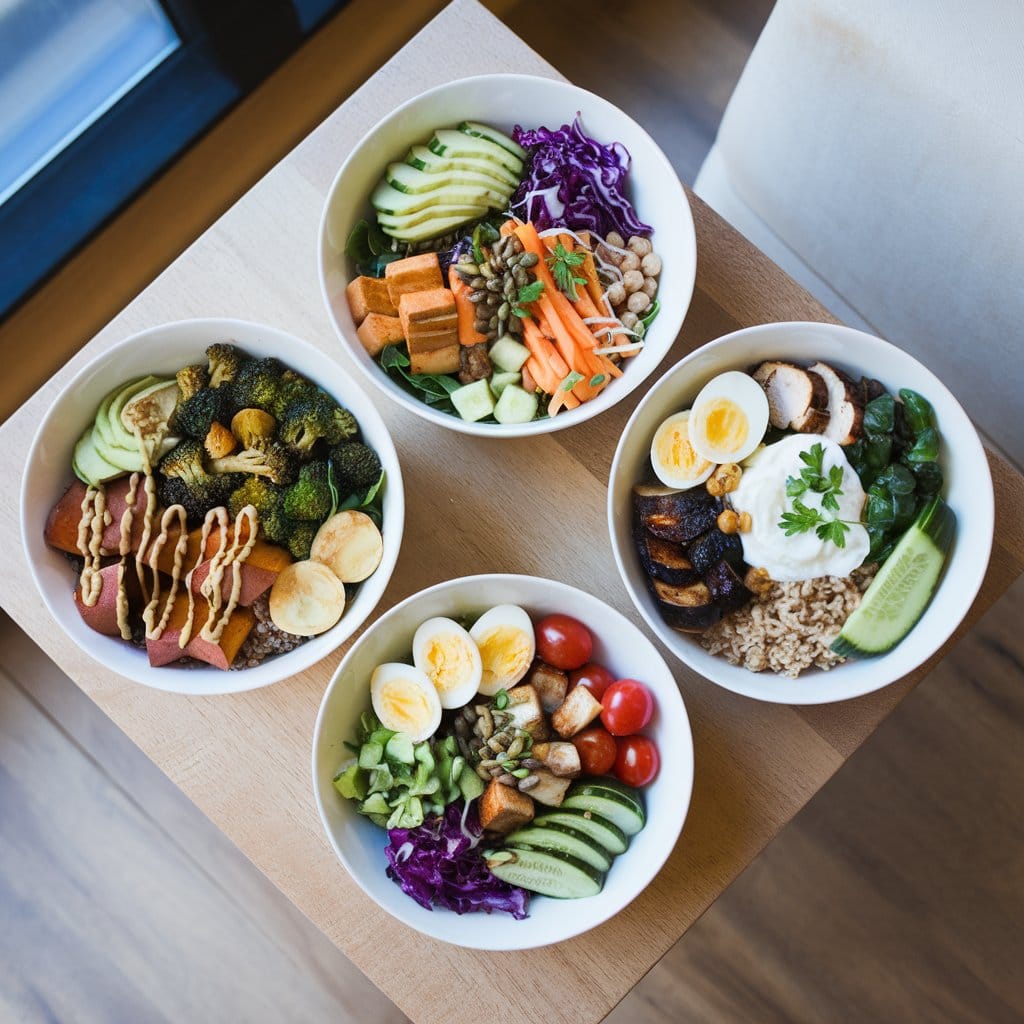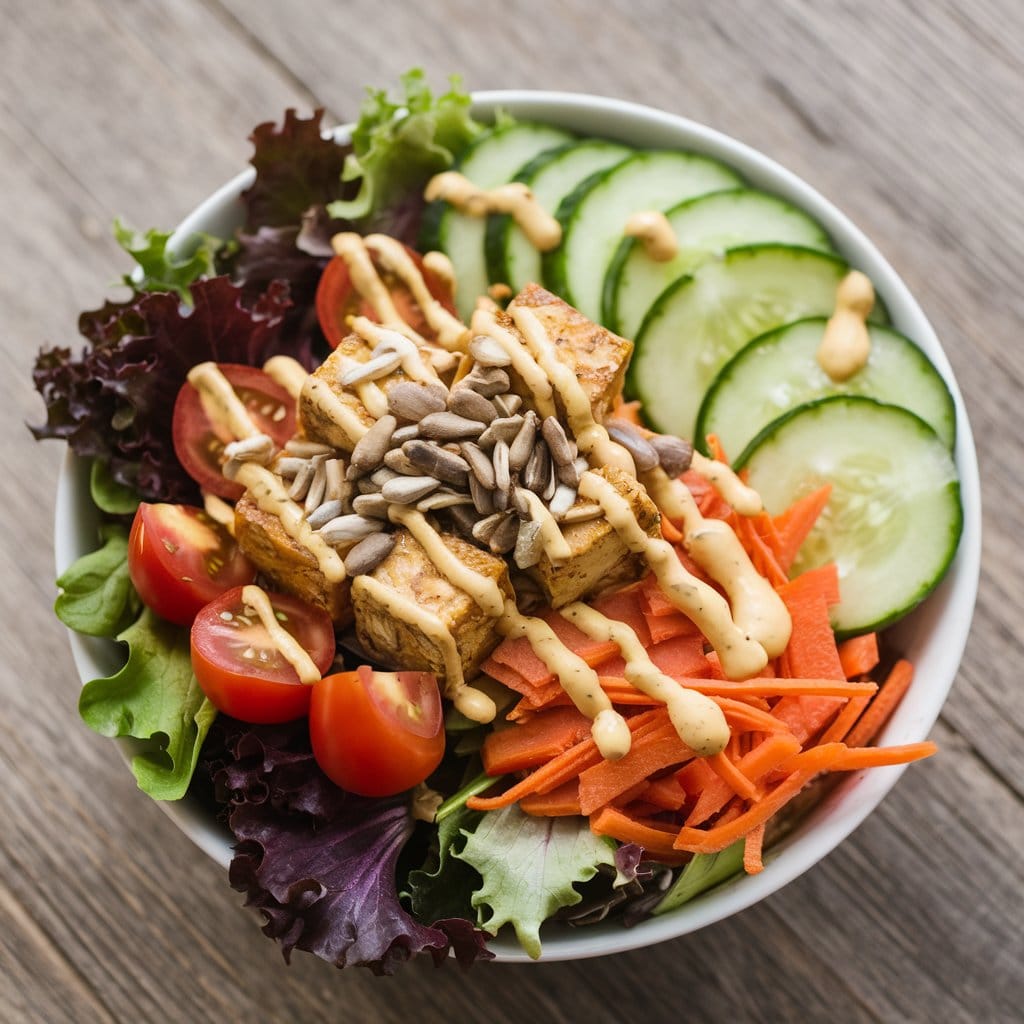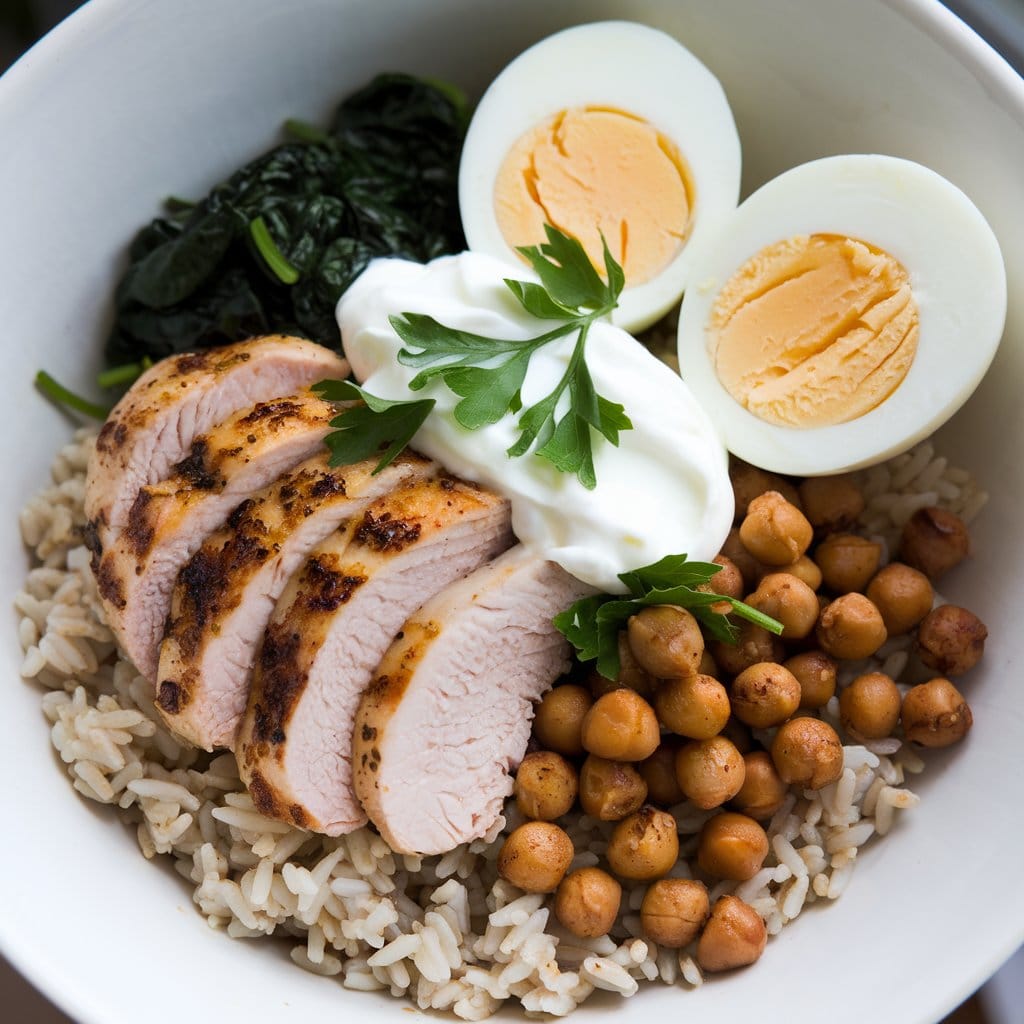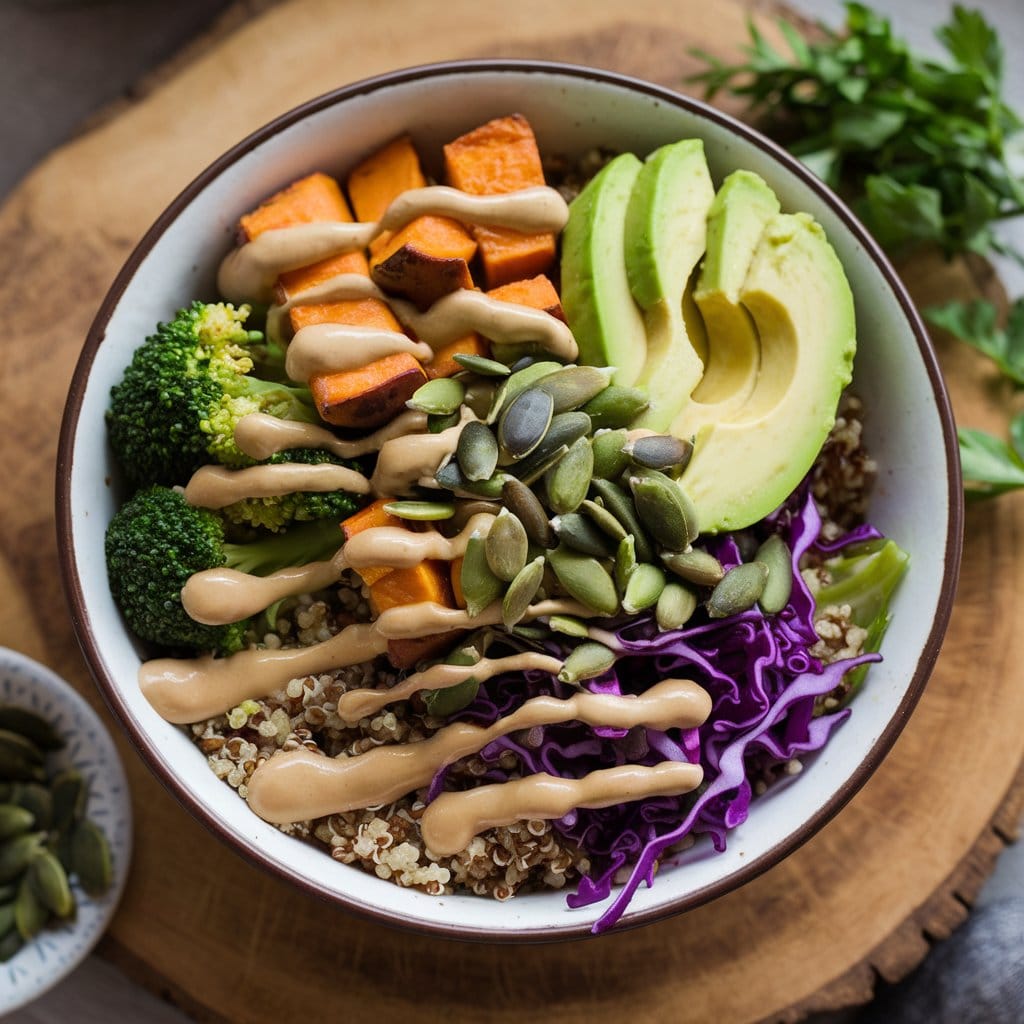Table of Contents
What Is a Vegan Buddha Bowl?
Imagine a bowl filled to the brim with vibrant, colorful veggies, hearty grains, and protein-packed toppings. That’s what a vegan Buddha bowl is all about—a delicious, balanced, and Instagram-worthy meal! But what makes these bowls so special? Let’s dig into their origins and components.
The Origins of Buddha Bowls
Buddha bowls are thought to get their name from their “rounded belly” look—much like a Buddha’s belly! They’re essentially a mix of wholesome, plant-based foods served in a single bowl. This style of eating is rooted in balance, harmony, and mindfulness. Sounds pretty zen, right?
Key Components of a Buddha Bowl
The magic of a Buddha bowl lies in its simplicity. It usually includes:
- A base: Think quinoa, rice, or greens.
- Veggies: Roasted, raw, or steamed—your pick!
- Protein: Tofu, chickpeas, lentils—plant-based goodness.
- Toppings: Seeds, nuts, or a drizzle of creamy dressing.
Why Are They Called Buddha Bowls?
Legend has it that Buddha would walk with a bowl, collecting food offerings. The modern Buddha bowl draws inspiration from this idea—a generous, balanced mix of flavors and nutrients in one place. It’s not just a meal; it’s an experience.
The Health Benefits of Vegan Buddha Bowls
We all know the saying, “You are what you eat.” Well, eating a Buddha bowl can make you feel like a health guru! Here’s why they’re so good for you.

Nutrient-Packed Ingredients for a Healthy Meal
Buddha bowls are bursting with nutrients. From vitamin-rich veggies to fiber-packed grains, they’re like a multivitamin in a bowl. Plus, they’re low in processed ingredients. Win-win!
How Vegan Buddha Bowls Support Weight Management
Trying to shed a few pounds? Buddha bowls are a perfect ally. They’re filling, thanks to the fiber, but low in empty calories. It’s like having your cake and eating it too—minus the guilt.
Boosting Your Energy with Plant-Based Proteins
Feeling sluggish? Swap your processed snacks for a Buddha bowl. Ingredients like chickpeas, quinoa, and tofu pack a protein punch, giving you sustained energy throughout the day.
Common Ingredients for Vegan Buddha Bowls
You might be wondering, “What exactly goes into a Buddha bowl?” Here’s a quick guide to the stars of the show.
Essential Grains and Their Nutritional Value
Grains like quinoa, brown rice, or farro act as the foundation. Not only do they add bulk, but they’re also rich in complex carbs that keep you energized.
| Grain | Calories (per cup cooked) | Protein | Fiber |
|---|---|---|---|
| Quinoa | 222 | 8g | 5g |
| Brown Rice | 215 | 5g | 4g |
| Farro | 170 | 6g | 5g |
Colorful Vegetables and Their Role in a Balanced Diet
Picture this: roasted sweet potatoes, crunchy kale, and fresh cucumber slices. Veggies not only add color but also a variety of vitamins, minerals, and antioxidants.
Plant-Based Proteins: Tofu, Tempeh, and Legumes
Proteins are the MVPs of any Buddha bowl. Whether it’s smoky tempeh, roasted chickpeas, or marinated tofu, they bring flavor and fuel.
Healthy Toppings and Dressings for Maximum Flavor
Let’s talk toppings! Seeds, nuts, or creamy tahini dressing take your bowl to the next level. Think of them as the cherry on top—except way healthier.
How to Build the Perfect Vegan Buddha Bowl
Creating a vegan Buddha bowl is an art, a science, and a delicious journey all rolled into one. Whether you’re a seasoned chef or a beginner in the kitchen, following these steps will guarantee you a bowl that’s not only nutritious but also bursting with flavor and visual appeal. Let’s break it down step by step:
Step 1: Choosing the Right Base
Your base is the foundation of the bowl, much like the canvas of a painting. A well-chosen base adds texture, flavor, and nutritional value.
- Grains: Popular options include quinoa, brown rice, wild rice, or farro. Quinoa, in particular, is a nutritional powerhouse with high protein content and a fluffy texture. If you prefer something heartier, go for brown rice—it’s chewy, nutty, and comforting.
- Greens: Leafy greens like spinach, kale, arugula, or mixed salad greens are lighter options. They add a fresh, crisp element to your bowl and are rich in vitamins like A, C, and K.
- Other bases: Want something different? Try cauliflower rice, sweet potato mash, or even soba noodles for an Asian-inspired twist.
Pro Tip: Mix and match! Use a combination of grains and greens to create a multi-dimensional base.
Step 2: Adding a Variety of Vegetables
Vegetables are the heart and soul of a Buddha bowl. Their vibrant colors, textures, and flavors make your bowl a feast for the eyes and palate. Here’s how to choose and prepare your veggies:
- Roasted Vegetables: Roasting veggies like sweet potatoes, Brussels sprouts, or bell peppers brings out their natural sweetness. Just toss them with olive oil, salt, and pepper, and pop them in the oven.
- Steamed Vegetables: Broccoli, asparagus, or snap peas are great options for steaming. This cooking method preserves their crunch and nutritional value.
- Raw Vegetables: For a fresh and crisp contrast, add raw veggies like cherry tomatoes, shredded carrots, cucumbers, or radishes. They bring a refreshing crunch to balance out the bowl.
Pro Tip: Aim for a variety of colors—think of it as eating a rainbow. Different colors often mean different nutrients, so you’ll be covering your nutritional bases too.
Step 3: Incorporating Protein-Rich Ingredients
Protein is essential for making your Buddha bowl satisfying and keeping you full. Luckily, plant-based proteins are both delicious and versatile.
- Tofu: Marinate tofu in soy sauce, garlic, and ginger, then bake or pan-fry until golden and crispy. It absorbs flavors beautifully, making it a crowd favorite.
- Tempeh: Tempeh has a firmer texture and a nutty flavor. Slice it thin, marinate in a smoky BBQ sauce, and grill or bake for a savory addition.
- Legumes: Chickpeas, black beans, or lentils are simple, budget-friendly options. Roast chickpeas with spices like paprika and cumin for a crunchy topping.
- Edamame: These green soybeans are protein-packed and ready to eat after a quick steam or microwave.
Pro Tip: Combine different proteins to keep it exciting. For example, mix roasted chickpeas with marinated tofu for a flavor and texture combo that’s hard to beat.
Step 4: Finishing with Toppings and Dressing
This is where your Buddha bowl truly comes to life! Toppings and dressings add layers of flavor, texture, and visual appeal.
- Crunchy Toppings: Seeds like sesame, sunflower, or pumpkin add crunch and a dose of healthy fats. Crushed nuts like almonds or peanuts are also great for texture.
- Fresh Herbs: A sprinkle of fresh cilantro, parsley, or mint can elevate your bowl’s flavor profile instantly.
- Fruits: For a touch of sweetness, add sliced avocado, pomegranate seeds, or mango chunks. They provide a delightful contrast to savory elements.
- Dressing Options:
- Tahini Sauce: Mix tahini, lemon juice, garlic, and a splash of water for a creamy, nutty dressing.
- Lime Vinaigrette: Whisk together lime juice, olive oil, and maple syrup for a zesty, tangy drizzle.
- Spicy Peanut Sauce: Combine peanut butter, soy sauce, ginger, and a dash of sriracha for a bold and savory dressing.
Pro Tip: Don’t skimp on the dressing! A well-balanced sauce ties all the components together, making your bowl sing with flavor.
“A Buddha bowl is more than just a meal. It’s a canvas for creativity and a step toward mindful eating. Fill it with what you love, and let the magic happen!”
Popular Vegan Buddha Bowl Recipes
Now that you know what makes a great Buddha bowl, let’s talk recipes! These bowls are not just about eating healthy; they’re about enjoying the process of creating something beautiful and delicious. Here are a few recipes that are simple, satisfying, and perfect for any occasion.
Simple Everyday Buddha Bowl Recipe

This bowl is your go-to for busy days when you want something quick and nourishing.
Ingredients:
| Ingredient | Quantity |
|---|---|
| Cooked quinoa | 1 cup |
| Roasted sweet potatoes | 1 cup (cubed) |
| Steamed broccoli | 1 cup |
| Chickpeas (cooked) | ½ cup |
| Tahini dressing | 2 tbsp |
| Mixed greens | 1 cup |
Instructions:
- Start by layering quinoa and greens in your bowl.
- Add the sweet potatoes, broccoli, and chickpeas on top.
- Drizzle with tahini dressing and sprinkle with sesame seeds. Done!
High-Protein Buddha Bowl for Athletes

Need something more robust? This recipe is packed with protein to fuel your workouts.
Ingredients:
| Ingredient | Quantity |
|---|---|
| Brown rice | 1 cup (cooked) |
| Tofu (cubed and baked) | 1 cup |
| Edamame | ½ cup |
| Red bell peppers | 1 cup (sliced) |
| Avocado | ½ (sliced) |
| Peanut sauce | 2 tbsp |
Instructions:
- Arrange the rice as the base, then top with tofu and edamame.
- Add fresh red peppers and creamy avocado slices.
- Drizzle with peanut sauce for a protein-packed meal.
Gluten-Free and Allergy-Friendly Buddha Bowl

Eating with dietary restrictions? No worries—this bowl is as inclusive as it gets.
Ingredients:
| Ingredient | Quantity |
|---|---|
| Wild rice | 1 cup (cooked) |
| Zucchini noodles | 1 cup |
| Lentils (cooked) | ½ cup |
| Roasted carrots | 1 cup (sliced) |
| Hummus | 2 tbsp |
| Pumpkin seeds | 1 tbsp |
Instructions:
- Place wild rice and zucchini noodles in your bowl as the base.
- Add lentils and roasted carrots for flavor and nutrition.
- Finish with a dollop of hummus and sprinkle of pumpkin seeds.
Common Problems and Solutions When Making Vegan Buddha Bowls
Let’s face it—sometimes things don’t go as planned. Here are a few common problems and easy fixes to keep your bowls looking and tasting great.
Problem: Bowls Turn Out Bland
Does your Buddha bowl feel like it’s missing something? This is a common challenge for beginners.
Solution: Amp up the flavor with bold dressings and spices. A zesty lemon-tahini dressing or a spicy peanut sauce can work wonders. Don’t forget fresh herbs like cilantro or parsley for an extra punch.
Problem: Lack of Protein in Your Bowl
If your bowl leaves you hungry an hour later, you might not have enough protein.
Solution: Incorporate more protein-rich foods like lentils, tofu, tempeh, or edamame. Even a sprinkle of hemp seeds can add a protein boost.
Problem: Limited Ingredient Availability
Can’t find quinoa or specific veggies? Don’t sweat it.
Solution: Be flexible! Use what’s in your pantry. Swap quinoa for rice, kale for spinach, or tofu for beans. Buddha bowls are all about creativity.
Where to Find Inspiration for Vegan Buddha Bowls
Feeling stuck in a recipe rut? Here are some resources to spark your imagination.
Online Recipe Platforms and Blogs
Websites like Pinterest, Minimalist Baker, and Oh She Glows are treasure troves of creative Buddha bowl recipes. Just type “Vegan Buddha Bowl” into the search bar, and let the ideas flow.
Social Media and Influencers to Follow
Platforms like Instagram and TikTok are filled with foodies showcasing their unique bowl creations. Search hashtags like #BuddhaBowl or #VeganEats for fresh ideas.
Local Vegan Cafes and Restaurants
Sometimes, the best inspiration comes from dining out. Visit a local vegan café, try their Buddha bowls, and take notes on ingredients and flavor combinations.
The Environmental Impact of Vegan Buddha Bowls
One of the coolest things about Buddha bowls is their eco-friendly vibe. By eating more plant-based meals, you’re not just nourishing yourself—you’re helping the planet too.
How Plant-Based Eating Supports Sustainability
Plant-based foods require fewer resources to produce than animal products. A single bowl of veggies, grains, and legumes has a much smaller carbon footprint compared to a meat-heavy meal.
Reducing Food Waste with Buddha Bowl Creations
Got leftover veggies, grains, or beans? Toss them into a Buddha bowl! It’s a great way to minimize food waste while making something delicious.
Creating a Vegan Buddha Bowl is a fun and creative way to incorporate healthy ingredients into your diet. For more wholesome meal prep ideas, explore these Mason Jar Salads, perfect for on-the-go lunches. Craving variety in your wraps? Try the versatile and delicious Veggie Wraps for a quick and satisfying meal. And if you’re looking for hearty, comforting recipes, this Lentil Soup pairs beautifully with your Buddha bowl creations.
